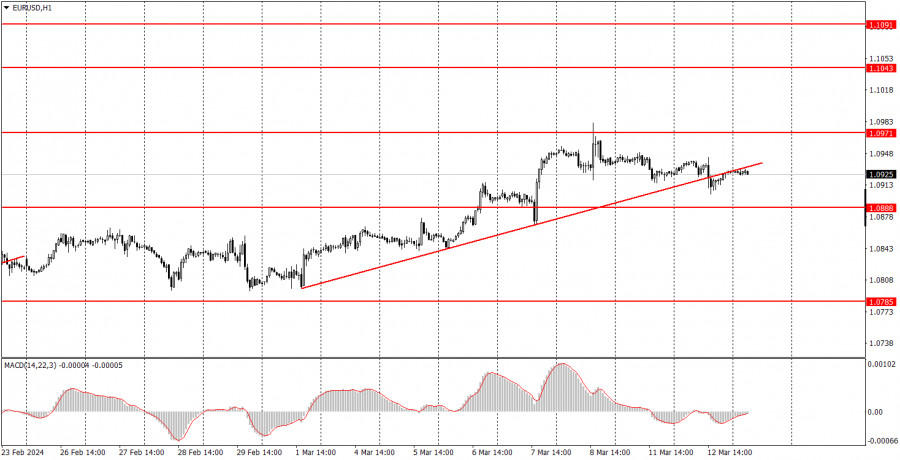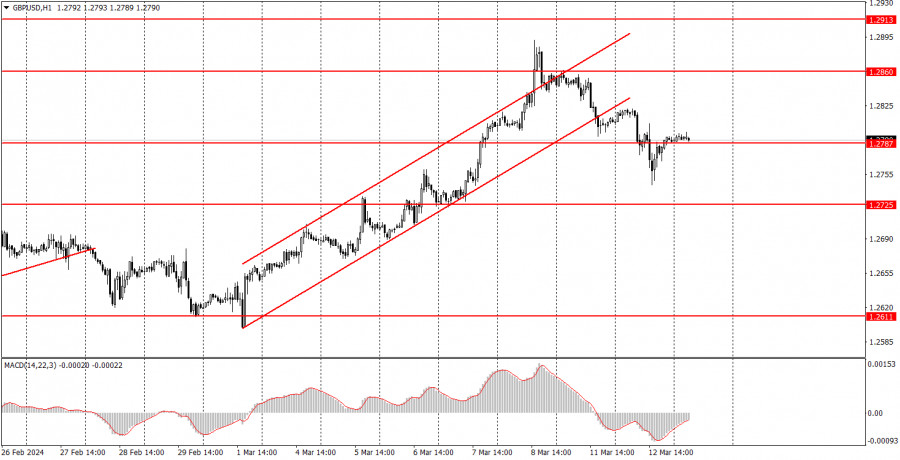

There are several macroeconomic events scheduled for Wednesday, but all of them are secondary reports. We will only highlight the Eurozone and UK industrial output data, as well as the UK GDP report for January. Take note that monthly GDP data are less significant than quarterly or annual data. Furthermore, GDP reports rarely evoke strong reactions from traders.
We have a perfect example from yesterday. The UK released important data on unemployment, unemployment benefit claims, and wage data. But the market's reaction was only 20 pips. Although the British pound is trading more actively than the euro, the response is still relatively weak.
Analysis of fundamental events:
There are also few fundamental events planned for Wednesday. We have European Central Bank representatives Cipollone and Jochnick delivering speeches today. However, what comments can we expect from them? Many heads of much larger central banks have already said that the first rate cut is likely to take place in June. Cipollone and Jochnick are unlikely to add anything new. Meanwhile, the "blackout period" has started for the Federal Reserve, as the second meeting of the year is scheduled for March 20th.
General conclusion:We expect both instruments to continue their respective downward movements. The only question is the strength of this movement. While the British pound has been reluctant to fall over the past two days, the euro is merely pretending to decline. We expect volatility to remain weak.
Basic rules of a trading system:1) Signal strength is determined by the time taken for its formation (either a bounce or level breach). A shorter formation time indicates a stronger signal.
2) If two or more trades around a certain level are initiated based on false signals, subsequent signals from that level should be disregarded.
3) In a flat market, any currency pair can produce multiple false signals or none at all. In any case, the flat trend is not the best condition for trading.
4) Trading activities are confined between the onset of the European session and mid-way through the U.S. session, after which all open trades should be manually closed.
5) On the 30-minute timeframe, trades based on MACD signals are only advisable amidst substantial volatility and an established trend, confirmed either by a trendline or trend channel.
6) If two levels lie closely together (ranging from 5 to 15 pips apart), they should be considered as a support or resistance zone.
How to read charts:Support and Resistance price levels can serve as targets when buying or selling. You can place Take Profit levels near them.
Red lines represent channels or trend lines, depicting the current market trend and indicating the preferable trading direction.
The MACD(14,22,3) indicator, encompassing both the histogram and signal line, acts as an auxiliary tool and can also be used as a signal source.
Significant speeches and reports (always noted in the news calendar) can profoundly influence the price dynamics. Hence, trading during their release calls for heightened caution. It may be reasonable to exit the market to prevent abrupt price reversals against the prevailing trend.
Beginners should always remember that not every trade will yield profit. Establishing a clear strategy coupled with sound money management is the cornerstone of sustained trading success.